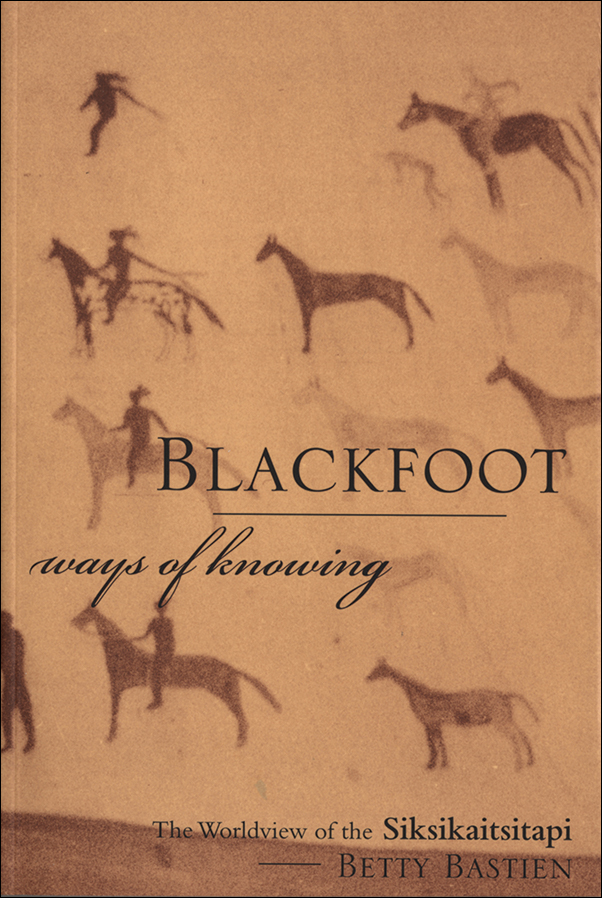
Blackfoot Ways of Knowing: The Worldview of the Siksikaitsitapi
Betty Bastien, , Edited by Jurgen W. Kremer,, and Assisted by Duane Mistaken Chief
$74.99 HB / $34.95 PB (S)
255 pages, 13 illustrations
6 x 9 inches
Hardback: 978-1-77385-422-9
Paperback: 978-1-55238-109-0
Library PDF: 978-1-55238-295-0
June 2004
A journey into the heart of and soul of Blackfoot culture that places tradition within historical context, offering a gateway into the worldview of the Siksikaitsitapi and a hope to ensure that the next generation of Indigenous people will enjoy a future of growth and peace.
Blackfoot Ways of Knowing is a journey into the heart and soul of Blackfoot culture. As a scholar and researcher, Betty Bastien places Blackfoot tradition within a historical context of precarious survival amid colonial displacement and cultural genocide. In sharing her personal story of reclaimed identity, Bastien offers a gateway into traditional Blackfoot ways of understanding and experiencing the world.
For the Siksikaitsitapi, knowledge is experiential, participatory, and ultimately sacred. Bastien maps her own process of coming to know, stressing the recovery of the Blackfoot language and Blackfoot notions of reciprocal responsibilities and interdependence.
Rekindling traditional ways of knowing is essential for Indigenous peoples in Canada to heal and rebuild their communities and cultures. By sharing what she has learned, Betty Bastien hopes to ensure that the next generation of Indigenous people will enjoy a future of hope and peace.
Betty Bastien was an instructor in indigenous studies at the University of Calgary. Her experience included teaching and curriculum design at Red Crow Community College, in the Native studies department at the University of Lethbridge, and at the University of Calgary.
Jurgen W. Kremer, who contributes an afterword to the book, is an executive editor of ReVision – Journal of Consciousness and Transformation. He has written about ethnoautobiography, dissociation, healing and cosmology, and violence against indigenous peoples.
Duane Mistaken Chief provides language consultation and is a senior instructor and lecturer in Blackfoot language and Blackfoot ways of life at Red Crow Community College on the Blood Reserve.
Foreword by Pete Standing Alone (Nii’ta’kaiksa’maikoan)
Preface by Betty Bastien (Sikapinaki)
Blackfoot (Siksikaitsipowahsin) Pronunciation Key by Duane Mistaken Chief, Sr.
I. Context
1.Introduction
2. Innahkootaitsinnika’topi – History of the Blackfoot–Speaking Tribes
2.1 Introductory Remarks
2.2. Iitotasimahpi Iimitaikes – The Era of the Dog or the Time of the Ancestors (Pre–Eighteenth Century)
2.3. Ao’ta’sao’si Ponokaomita – The Era of the Horse (Eighteenth Century to 1880)
2.4 Ao’maopao’si – From when we settled in one place (1880)
3. Cultural Destruction – Policies of Ordinary Genocide
II. Tribal Protocol and Affirmative Inquiry
4. Niinohkanistssksinipi – Speaking Personally
5. Traditional Knowledge in Academe
6. Cultural Affirmation
7. Protocol of Affirmative Inquiry
III. Affirmation of Indigenous Knowledge
8. Kakyosin – Traditional Knowledge
9. Kiiomohpiipotoko – Ontological Responsibilities
10. Siksikaitsitapi Ways of Knowing – Epistemology
11. Knowledge is Coming to Know Ihtsipaitapiiyo’pa
12. Kakyosin/Mokaksin – Indigenous Learning
13. Niitsi’powahsinni – Language
14. Aipommotsspistsi – Transfers
15. Kaaahsinnooniksi – Grandparents
IV. Conclusion: Renewal of Ancestral Responsibilities as Antidote to Genocide
16. Deconstructing to Colonized Mind
17. Eurocentred and Niitsiapi Identity
18. Reflections and Implications
Afterword: Remembering Ancestral Conversations by Jürgen W. Kremer
Glossaries by Duane Mistaken Cheif with Jürgen W. Kremer
Siksikaitsipowahsin–English
English–Siksikaitsipowahsin
Biblography
Betty Bastien’s ambitious goal is no less than the decolonization of Blackfoot ways of knowing as a vehicle to regaining independence, promoting personal and cultural healing, and providing a basis for a new educational system . . . Bastien has done a good job in capturing the complex issues that concern many Blackfoot elders who are striving to live by means of traditional teachings and fulfilling the responsibilities that come with having a “good heart.”
——Patricia A. McCormack, Great Plains Quarterly
Bastien has produced an important work that lays the foundation for making the Blackfoot way of knowing more accessible.Her discussions of Siksikaitsitapi ontology and pedagogy offer culturally appropriate ways of transferring this knowledge through a Siksikaitsitapi-controlled education system. Russel Wright, the late Siksika teacher and elder often said, “We have been studied to death. It is time we start studying ourselves back to life.” He would have been proud of Betty Bastien’s study.
—Gerald T. Contay, Histoire social/Social History
A highly significant description of traditional religion and epistemology within the Blackfoot culture written by a member of this cultural community. Many books of Native American and/or First Nations religions are little more than condescending presentations of “mythology” with little to no cultural context. Ms. Bastien’s work is the opposite, and manages to present a worldview that is radically different than the mainstream Western one with dignity and complexity.
—Conan Van Der Crom, GoodReads